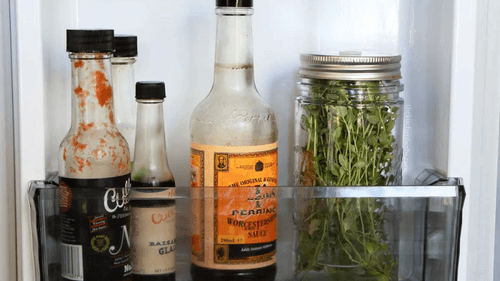Can you freeze Thyme? Best methods for freezing
Thyme must be the most popular herb of all time. It is excellent with pork, chicken, and lamb. You can make Thyme tea, and if you grow Thyme in your garden, you will know how irresistible it is to touch to release its fragrance over your hands. Thyme has more medicinal properties than most vegetables, but how can you enjoy it all year round?

Did you know Thyme is antimicrobial and makes the perfect tea to heal a wet cough?
Thyme has been used in cooking and medicine since the Roman era. It is excellent at lowering inflammation and can help with many illnesses to enhance your quality of life.
The mysteries of Thyme are revealed in this article, mainly how to preserve it so that you can use it as a seasoning all year long. We address many frequently asked questions to help you hone your culinary talents.
Let’s get into it.
Does Thyme expire?

It does, indeed. On the plant and when harvested, Thyme leaves almost seem like they could survive anything, but their therapeutic properties begin to wane when they are harvested.
Thyme will dry out and lose its flavor in the cooking. Although it won’t last long, the odor in the kitchen will be fantastic. Fresh Thyme sprigs will remain fresh for 7 to 10 days if left outside. After that, they have a slimy look and an ugly appearance.
Thyme can be kept in the crisper drawer or the refrigerator. Depending on its freshness, Thyme keeps for about two weeks in the refrigerator.
Be cautious about keeping the Thyme dry in the refrigerator. It should be kept in a paper bag with the opening left open.
A whole Thyme twig can be toasted before being placed in an oil bottle. Impressive flavor infusion occurs as the oil maintains the Thyme, and the Thyme infuses the oil with its taste.
However, Thyme is used in many dishes and is considered the cornerstone of the most potent herbs with its medicinal benefits and unique flavor profile.
When you place Thyme in a beautiful soup of casserole, the shelf life of the Thyme will automatically be dictated by the dominant food.
Thyme, like either herb, can be stored in many ways and indeed bought fresh or dried from the store, which can substantially extend Thyme’s shelf life.
You might have predicted that Thyme can effectively be frozen because of how adaptable it is in the kitchen, but we’ll get to that in a minute.
Does Thyme need to be refrigerated?

It depends on the state of the Thyme. If it’s fresh, it should be stored in the fridge to preserve its shelf life. Sitting out on a window ledge fills the kitchen with its fragrance. The Thyme will only last for a few days.
Place Thyme in the fridge in an airtight plastic bag. You can place a damp paper towel around the base of the stems to add water so the Thyme is not drying out.
Or you can place Thyme in an open paper bag and leave it in the crisper. With either method, the Thyme should last a couple of weeks before it starts to deteriorate in the fridge.
If you follow this method, the Thyme should last for two weeks in the fridge and possibly longer.
If you have dry Thyme, it does not need to be stored in the fridge. You should keep it tightly sealed after using it to prevent the Thyme from absorbing moisture which could cause mold growth.
Does Thyme have to be covered in the fridge?
Thyme lasts best, either placed in a sealed polythene bag with a damp paper towel around the base of the stems or in a paper bag stored in the crisper.
Covering Thyme in the fridge is not essential, but it is wise if it extends the shelf life by multiple days.
Store dry Thyme in a tightly sealed jar in a cool dark place like a kitchen cabinet or pantry. It can be stirred in the fridge if you prefer, but there is no benefit, and you use valuable fridge space.
Can you put warm Thyme in the fridge?

It may seem like a stupid question, but if you take a step back, it is part of your meal. Maybe you have warm Thyme on the leftovers of your lamb dinner. So can it be placed in the fridge while warm?
The answer is no, and it is not just about Thyme. It’s about the whole meal that contains Thyme, from soups to the family roast. Placing warm food in the fridge is a bad idea.
If you read online that you can’t put a warm roast in the fridge because of condensation coalescing into water droplets that will drip and make your roast soggy and less appealing at best, this is why you can’t put the warm roast lamb with Thyme in the fridge, you are being misled.
Your fridge temperature will be 40℉ -18℃ or a little lower. Placing warm leftovers in the fridge will elevate its temperature while it radiates heat.
Your fridge may not be as efficient as you might have thought at removing heat. Most fridges take hours to come to 40℉ after being switched on after cleaning.
So, what’s the big deal? The big deal is that food sitting at a temperature of 40-140℉ is in the food danger zone. It’s not just your leftovers. It is the contents of the entire fridge.
Above 40℉-18℃ bacterial growth on perishable foods will accelerate exponentially. It should be discarded if the food remains at an elevated temperature above 40℉-18℃ for just two hours.
Seems harsh? According to the USDA, after two hours in the food danger zone, perishable foods contain enough bacteria to cause food poisoning.
How long can Thyme sit out?
As a herb, it could sit out for a day or two before it starts to deteriorate. But as part of a recipe, it should sit out for 2 hours and not more.
Remember the food danger zone? According to the USDA, perishable goods sitting out for two hours should be discarded, and the bacteria growth on the food has multiplied rapidly, making the food unfit for consumption.
Eating food sitting out for two hours or more could cause food poisoning.
This will only apply if Thyme is part of the recipe.
Does unopened Thyme go bad?
Spices are described as “aromatic vegetable compounds, in the whole, broken, or ground form, whose significant role in food is seasoning rather than nourishment (3 Trusted Source)” by the Food and Drug Administration (FDA).
Herbs are dried or fresh leaves, whereas spices are seasonings created from a plant’s dried roots, bark, or stem.
The kind, processing, and storage of dried herbs and spices are all factors to consider when calculating their shelf life. For instance, dried spices often have a longer shelf life than dried herbs, and the more natural or unprocessed a seasoning is, the more natural it is.
Usually, dried herbs are good for 1-3 years. Examples comprise:
- Basil
- Oregano
- Rosemary
- Thyme
- Bay leaf
- Dill
- Parsley
- Cilantro
- Mint
- Marjoram
- Sage
How long does Thyme last in the fridge?
7 to 14 days, it depends on the Thyme’s freshness and how it’s stored. Thyme is quite hardy, but it will deteriorate over time in the fridge, so to extend its shelf life, it’s recommended to keep it in a Ziploc bag with a damp paper towel.
Stored in the method and assuming the Thyme is fresh, the herb should last 14 days and possibly longer. If the leaves turn black and become slimy, you know it’s at the end of its life.
Does frozen Thyme go bad?
Thyme can last indefinitely if stored at 0℉ or below. The herb is recommended to be at its best within 3 to 6 months of freezing, but it can withstand the rigors of freezing for longer.
If you freeze Thyme longer than six months, you may notice the texture of the herb has changed, and the flavor has become more subtle, making it perfect for a Bourbon Thyme cocktail.
Freezing Thyme is child’s play. Here is a guide for you to follow.
Method 1: Freezing long stems of Thyme
- If you have long stems, there is no need to chop them up. Wash the stems and dry them, so they do not retain water.
- Select the sealable freezer bag you will be using. The stems will need to fit inside the bag so trim them.
- Wrap each stem in cling wrap. You can wrap it twice if you wish or once.
- Place each stem into the bag and remove as much air from the Ziploc bag as possible to help prevent freezer burn.
- Seal the bag and mark the bag with the freezing date and the expiry date.
- Place in the freezer.
Method 2: Freeze shorter stems of Thyme.
- Assuming the Thyme stems are clean and dry, chop them into individual pieces, maybe half stems.
- Place on a baking tray, so the stems are not touching.
- Put the freezing tray in the freezer for two hours.
- Retrieve the stems, and they should be frozen solid.
- Place the stems in a freezer bag (they will not refreeze into one big piece), remove as much air as possible, and seal the bag.
- Mark the bags with the freezing date and expiration date and freeze.
Method 3: Freezing the Thyme leaves
- Wash the Thyme and then dry it using a flicking motion to remove the water. Now run your fingers down the stems and remove the leaves. Pat dry the leaves if necessary.
- Place the leaves into an ice cube container or plastic egg container. Fill each receptacle and compress the leaves with your fingers, leaving some space.
- Cover with water and place in the freezer.
Final thoughts
Thyme is a wonderful herb and very versatile in its uses, from cooking to medicinal to even cocktail flavorings. Like most herbs, Thyme lasts for a couple of weeks if stored in the fridge correctly.
Freezing Thyme could not be easier, and you can have the flavors of fresh Thyme the whole year around.





